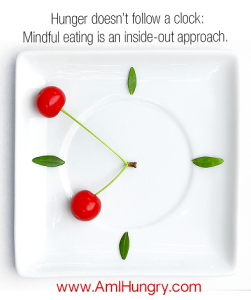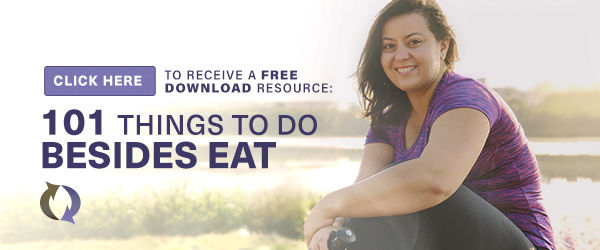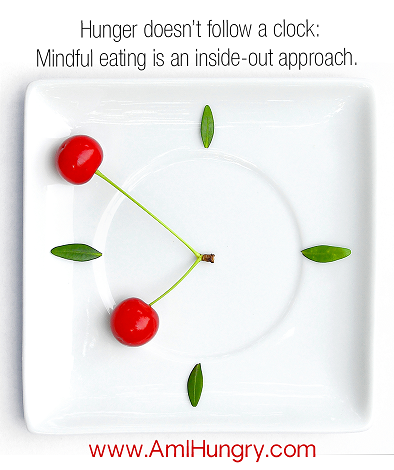There are endless diet rules that force you to disconnect so you aren’t able to listen to your body. Most diets have some kind of rule about when you “should” eat. But in reality, hunger doesn’t follow a clock or adhere to someone else’s schedule!
Have you ever tried to follow rules like these? (Notice that some conflict with others!)
Common diet rules about when to eat
 Eat within an hour of getting up.
Eat within an hour of getting up.- Don’t eat for at least 12 (or 14 or 16) hours.
- Eat breakfast, lunch, dinner, and two small snacks every day.
- Eat six small meals a day.
- Eat every three hours.
- Don’t let yourself get hungry!
- Don’t eat in the evening after 7 pm.
Eating in vivo
When I was in medical school, we learned about the important differences between in vitro studies performed in the lab, and in vivo studies performed on living subjects.
Theoretically, telling people to eat on a schedule seems like it should work, but when they try to follow rules for very long, it breeds obsession, inflexibility, and distrust in one’s self.
In real life, you may feel hungry frequently one day and rarely the next, depending on the types of foods you eat, how much you eat, your activity levels, hormones, and other factors.
When your hunger levels don’t match the rules of whatever diet you’re on, you end up “cheating” and feeling guilty—fueling the eat-repent-repeat cycle.
An inside-out approach to listen to your body
How you decide when to eat is another example of the difference between diets and mindful eating.
Diets are outside-in.
Am I Hungry? mindful eating programs are inside-out because you learn to listen to your body first so you can become the expert in yourself!
Diets depend on your willpower and compliance to follow strict rules as long as you can. When you can no longer follow the rules, you feel like a failure and give up.
Mindful eating shows you how to use your awareness and curiosity to learn about your personal hunger rhythms so you can create a pattern of eating that works for you.
This helps you easily adapt to the ever-changing circumstances that happen in life.
Let’s compare these two approaches: Outside-in, which require you to adhere to a set of predetermined rules, and inside-out which is all about learning to listen to your body.
(The following is based on the Eat What You Love, Love What You Eat book series.)
Outside-In: Eat within an hour of getting up.
Inside-Out: While many studies have shown that breakfast is an important meal to spark your internal thermostat, give you energy, and decrease overeating later in the day, not everyone is hungry first thing in the morning.
If that’s you, could you experiment with cutting down on late night eating, getting up a little earlier so you can slow down to eat, or cutting back on caffeine?
If you still aren’t hungry first thing in the morning, could you check in within a couple of hours after waking up and have some food available to eat?
Read more: Should I eat breakfast if I’m not hungry?
Outside-In: Don’t eat for 12 (or 14 or 16) hours.
Inside-Out: Despite decades of messages like, “breakfast is the most important meal of the day” (see above), intermittent fasting is the latest diet trend. For some, this pattern of eating fits nicely with their natural hunger rhythms, for example, people who aren’t hungry for breakfast.
Perhaps the best thing about this fad is it lessens the fear that we’ll “ruin our metabolism” by skipping a meal. Rather than eating (or not eating) on a schedule, listen to your body to guide you when it needs fuel.
Outside-In: Eat breakfast, lunch, dinner, and two small snacks daily.
Inside-Out: Your hunger patterns are affected by what and how much you eat.
If you eat less or more than usual at one meal, notice how long it takes before you’re hungry again. For example, if you eat a larger than normal lunch, notice whether and/or when you’re hungry for your usual afternoon snack.
Hunger is also affected by what you eat. Macronutrients (carbohydrates, proteins, and fats) are digested at different rates and cause the release of certain biochemicals that affect satiety.
Protein-containing foods are said to lead to the greatest level of satiety. You can create an experiment to test this for yourself: Compare what happens when you eat crackers with what happens when you eat crackers with peanut butter.
Foods high in fiber are said to slow down digestion, but test it for yourself: Is there a difference when you eat processed cereal versus when you eat oatmeal?
You may have noticed that the theme here is to experiment and listen to your body, rather than just mindlessly follow arbitrary rules.
Outside-In: Eat every three hours.
Inside-Out: Instead of automatically eating every three hours, check in every few hours. A Body-Mind-Heart Scan will allow you to notice when you’re becoming hungry as well as when you have other needs such as for water, rest, or a break.
(The Am I Hungry? Mindful Eating Virtual Coach App has a timer you can set to remind you to do your scan.)
Outside-In: Eat six small meals a day.
Inside-Out: This rule is probably based on the observation that some people who eat instinctively eat small regular meals. However, they don’t do it by following a clock. Let’s take a closer look and reverse engineer it to understand how they might do this.
People who eat instinctively naturally listen to their body. They are innately aware of their hunger and satiety cues. Since the stomach is about the size of their fist, it takes a handful of food or two to fill it comfortably without overstretching. If they stop eating when they’re satisfied and not uncomfortably full, they’re likely to become hungry every few hours throughout the day.
This instinctive small, frequent meal pattern keeps their blood sugar level and supplies them with a consistent fuel source, so they experience fewer mood and energy swings.
Instead of using an arbitrary schedule designed by someone else, learn how to listen to your body and practice eating in response to your hunger and fullness signals.
Outside-In: Don’t let yourself get hungry!
Inside-Out: This rule is based on the belief that people are incapable of managing their own eating and that if they get hungry, they’ll overeat. (Do you hear the distrust embedded in this message?)
In our experience, the opposite is true.
Once we teach people how to interpret their hunger and fullness signals to guide their eating (and how to tell the difference between physical hunger and all the other reasons we want to eat), they are quite capable of managing their eating without all these rigid rules.
Of course, being overly hungry can make it more difficult to eat slowly and stop when you feel satisfied, so experiment with trying not to let yourself get too hungry.
The inside-out approach cultivates trust and confidence, eliminating the need for chronic dieting.
Outside-In: Don’t eat after 7 pm.
Inside-Out: This rule is supposed to keep you from eating in the evening while watching TV or because you’re bored, lonely, or in need of a reward after working all day. If you’re simply following a rule, you may not realize the reasons you usually eat in the evenings. So, when you go off the diet (you know you will eventually), you’ll go back to eating in the evenings.
Try this. When you feel like eating in the evening, pause and ask yourself, “Am I hungry?” and look for physical signs that your body needs fuel.
If you’re hungry but going to bed soon, decide what to eat that will leave you feeling comfortable, so you’ll get a good night’s sleep.
If you’re not hungry, your challenging work begins. What other thoughts and feelings are you aware of that might be triggering the desire to eat? And what small step can you take to meet that need? (We do not take this part of the problem lightly! Understanding why you want to eat and learning to meet your needs more effectively is one of the keys to lasting change.)
Inside-Out Problem Solving: How to Listen to Your Body
Let’s say you notice you just aren’t hungry at a particular mealtime. This is an opportunity to engage your curiosity and think about what and how much you ate earlier that day. You can also think about whether anything else may have affected your hunger. With this new information, you can now experiment with various solutions.
For example, let’s say you notice you aren’t very hungry during your usual lunch hour. If you typically eat toast for breakfast and a protein bar for a snack mid-morning, you could experiment with adding protein (like an egg, peanut butter, or Greek yogurt) to your breakfast to see if it holds you longer so you can skip your mid-morning snack.
Or, you could experiment to see if eating a different snack, like a piece of fruit, would allow you to feel more hungry by lunch. Alternatively, you could try eating less at lunch and be prepared to have a mid-afternoon snack.
Similarly, if you want to be hungry (but not ravenous) for dinner with your family, you can experiment with different lunches and afternoon snacks to see what pattern works for you. Listen to your body!
By actively trying to listen to your body, you can adjust what and how much you eat to regulate your hunger rhythms. This way, the timing of hunger will become more convenient for your lifestyle and eating patterns.
Bottom line: Become your own expert by learning to understand and trust your body’s signals.
This article has been updated from a previously published version.
Enjoyed this article? Here are three more you might find helpful:
How to tell if you’re hungry: Symptoms of hunger
How to overcome a fear of hunger
End emotional eating by decoding your triggers


